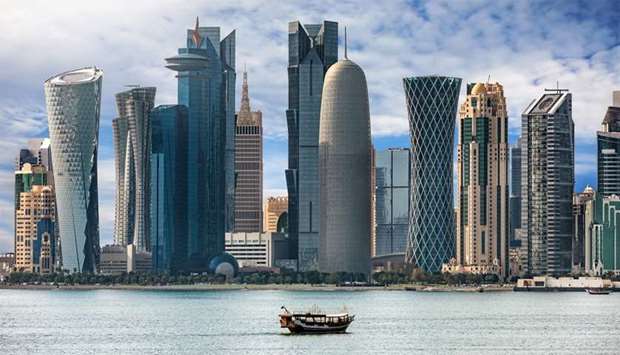Doha is slated to see imported and domestic inflation of 2%-3.5% during 2021-23, according to the latest Qatar Economic Outlook from the Planning and Statistics Authority (PSA).
The strengthening inflationary pressure is on account of the rise in prices of basic commodities in global markets, caused by the bottlenecks in commodity supply chains that have been so visible since the onset of the Covid-19 pandemic, as well as the "negative repercussions" of expansionary financial and monetary policies, PSA president Dr Saleh al-Nabit said in the report.
In light of the high degree of openness of the Qatari economy to foreign economies, which averages more than 90% using the total foreign trade (exports + imports) as a percentage of GDP or gross domestic product; the report said there is a "high" possibility that external factors have affected the level of inflation in Qatar during (October 2020-October 2021).
The external factors that may contribute to increase the costs of Qatari imports are the changes in prices of imported goods and services; the changes of transportation, shipping and unloading’s costs; and the changes in the exchange rate of the Qatari riyal against the currencies of Qatar’s trading partners.
Thanks to the Qatari riyal's peg to the US dollar, which is relatively stable and its purchasing power fluctuates against the currencies of many of Qatar's trading partners; it helps mitigate the damages of imported inflation during sudden changes.
The report highlighted that the Qatari riyal moves in a direction and changes its value at the same pace as the dollar indices, because it reflects the difference in prices and inflation of the trading partners of both the riyal and the dollar.
"They have gained purchasing power which may reduce the inflationary effects of Qatar's trading partners," it said.
Given the fact that Qatar imports more than 90% of its needs from international markets, one of the biggest factors affecting its price indices is international energy and non-energy prices, revealing the strength of the correlation between the Qatari CPI, and global energy and non-energy price indices according to the World Bank database.
The consumer price inflation rates in Qatar witnessed significant increases during the past twelve months, rising from negative 2.95% in November 2020 to positive 6.1% November 2021, which indicates that price recovery is higher than in 2020 by more than 300%.
There is an almost total correlation between domestic price indicators and international prices for energy and non-energy sectors, especially during 2020-21, which were affected by the economic repercussions of imposing Covid-19 containment measures and then gradually lifting them in all countries.
The activities related to transportation and tourism that were affected by the repercussions of Covid-19 during 2020, including hospitality, accommodation, arts and entertainment, were also behind the price hike during the last three quarters of 2021, in particular after the gradual lifting of restrictions imposed on those activities, especially transportation, restaurants, and parks.
The strengthening inflationary pressure is on account of the rise in prices of basic commodities in global markets, caused by the bottlenecks in commodity supply chains that have been so visible since the onset of the Covid-19 pandemic, as well as the "negative repercussions" of expansionary financial and monetary policies, PSA president Dr Saleh al-Nabit said in the report.
In light of the high degree of openness of the Qatari economy to foreign economies, which averages more than 90% using the total foreign trade (exports + imports) as a percentage of GDP or gross domestic product; the report said there is a "high" possibility that external factors have affected the level of inflation in Qatar during (October 2020-October 2021).
The external factors that may contribute to increase the costs of Qatari imports are the changes in prices of imported goods and services; the changes of transportation, shipping and unloading’s costs; and the changes in the exchange rate of the Qatari riyal against the currencies of Qatar’s trading partners.
Thanks to the Qatari riyal's peg to the US dollar, which is relatively stable and its purchasing power fluctuates against the currencies of many of Qatar's trading partners; it helps mitigate the damages of imported inflation during sudden changes.
The report highlighted that the Qatari riyal moves in a direction and changes its value at the same pace as the dollar indices, because it reflects the difference in prices and inflation of the trading partners of both the riyal and the dollar.
"They have gained purchasing power which may reduce the inflationary effects of Qatar's trading partners," it said.
Given the fact that Qatar imports more than 90% of its needs from international markets, one of the biggest factors affecting its price indices is international energy and non-energy prices, revealing the strength of the correlation between the Qatari CPI, and global energy and non-energy price indices according to the World Bank database.
The consumer price inflation rates in Qatar witnessed significant increases during the past twelve months, rising from negative 2.95% in November 2020 to positive 6.1% November 2021, which indicates that price recovery is higher than in 2020 by more than 300%.
There is an almost total correlation between domestic price indicators and international prices for energy and non-energy sectors, especially during 2020-21, which were affected by the economic repercussions of imposing Covid-19 containment measures and then gradually lifting them in all countries.
The activities related to transportation and tourism that were affected by the repercussions of Covid-19 during 2020, including hospitality, accommodation, arts and entertainment, were also behind the price hike during the last three quarters of 2021, in particular after the gradual lifting of restrictions imposed on those activities, especially transportation, restaurants, and parks.


